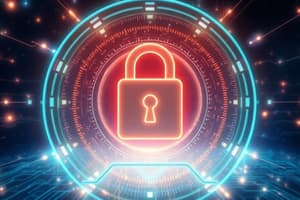Podcast
Questions and Answers
What is the primary function of FileVault in macOS?
What is the primary function of FileVault in macOS?
- To reduce system modifications by malware
- To detect and remove malware
- To provide full-disk encryption (correct)
- To block unauthorized applications from running
Which tool is specifically designed to scan and block known malicious software in macOS?
Which tool is specifically designed to scan and block known malicious software in macOS?
- System Integrity Protection (SIP)
- Time Machine
- XProtect (correct)
- Gatekeeper
What is a key benefit of automating the patch management process?
What is a key benefit of automating the patch management process?
- Reduces the need for scheduling maintenance windows
- Ensures critical updates are applied without delay (correct)
- Eliminates the need for testing patches
- Prevents any compatibility issues
What is a potential challenge of patch management?
What is a potential challenge of patch management?
Which component in macOS limits the actions of the root user to enhance security?
Which component in macOS limits the actions of the root user to enhance security?
Which method enhances user authentication beyond standard passwords?
Which method enhances user authentication beyond standard passwords?
What does Role-Based Access Control (RBAC) primarily manage?
What does Role-Based Access Control (RBAC) primarily manage?
Which encryption method is specifically designed for protecting Windows data?
Which encryption method is specifically designed for protecting Windows data?
What role does User Account Control (UAC) serve in Windows security?
What role does User Account Control (UAC) serve in Windows security?
Which technology provides encrypted remote access to Linux systems?
Which technology provides encrypted remote access to Linux systems?
What security feature in Linux enforces strict access controls and reduces damage from exploits?
What security feature in Linux enforces strict access controls and reduces damage from exploits?
Which of the following describes the function of a firewall in a Linux environment?
Which of the following describes the function of a firewall in a Linux environment?
Which auditing feature is essential for maintaining records of system events?
Which auditing feature is essential for maintaining records of system events?
Flashcards are hidden until you start studying
Study Notes
User Authentication
- Ensures only authorized users access the system.
- Methods include password protection, biometrics, and multi-factor authentication (MFA).
Access Control
- Limits user and program actions on a system.
- Techniques include Role-Based Access Control (RBAC) and Mandatory Access Control (MAC) to assign specific permissions.
Encryption
- Protects data by converting it into unreadable formats.
- OS-level encryption like BitLocker (Windows) or FileVault (macOS) secures sensitive data in storage and transit.
Auditing and Logging
- Keeps records (logs) of system events, including access attempts, user activities, and OS changes.
Malware Protection
- Anti-malware and antivirus software scan the system for malicious software like viruses, trojans, and ransomware, to remove or quarantine threats.
Securing Windows
- Windows Defender is a built-in antivirus program.
- BitLocker provides full disk encryption.
- User Account Control (UAC) prevents unauthorized system changes by requiring user consent for administrative tasks.
- Windows Firewall filters network traffic and blocks malicious access attempts.
- Active Directory (AD) allows centralized user and security management in enterprise environments.
- Group Policy helps enforce security rules across multiple machines.
Securing Linux
- SELinux (Security-Enhanced Linux) enforces strict access controls for system processes, limiting potential damage from vulnerabilities.
- Linux file permissions and ownership ensure only authorized users or processes can access specific files.
- SSH provides encrypted remote access to Linux systems, reducing the risk of man-in-the-middle attacks.
- Linux firewalls like iptables and ufw create rules to filter network traffic and block malicious connections.
Securing MacOS
- FileVault is macOS’s built-in encryption system providing full-disk encryption.
- Gatekeeper prevents unauthorized apps from running by only allowing apps downloaded from the App Store or identified developers.
- XProtect is a built-in malware detection tool that scans and blocks known malicious software.
- System Integrity Protection (SIP) limits the actions the root user can perform on protected parts of the system.
Patch Management
- Key Steps:
- Vulnerability Identification: Identify potential vulnerabilities using scanning tools or vendor alerts.
- Patch Deployment: Roll out patches to fix identified vulnerabilities, either manually or through automated systems.
- Testing and Validation: Test patches in a non-production environment before deployment.
- Automation and Scheduling: Automate the patching process and establish regular schedules to stay current.
- Challenges:
- Compatibility issues: Patches may cause compatibility problems with existing software or hardware.
- Downtime: Applying patches might require system restarts or maintenance windows.
- Delays: Failure to apply patches quickly increases the risk of cyberattacks exploiting unpatched vulnerabilities.
Studying That Suits You
Use AI to generate personalized quizzes and flashcards to suit your learning preferences.





